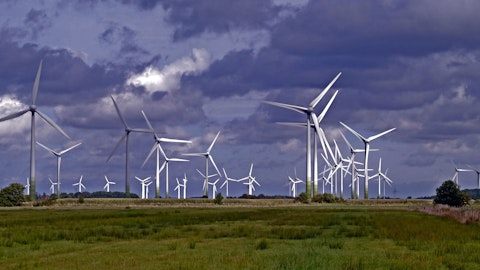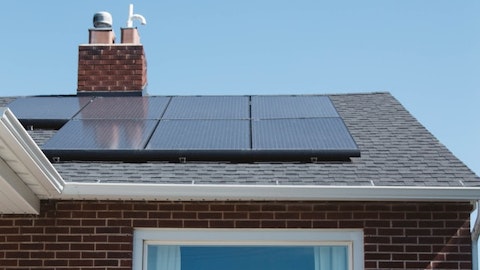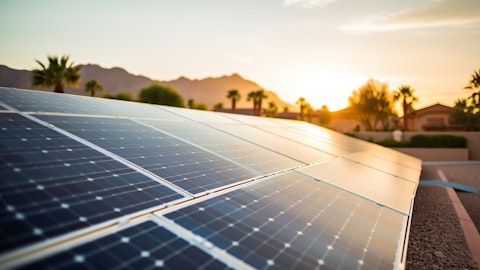Clearway Energy, Inc. (NYSE:CWEN) Q4 2023 Earnings Call Transcript February 22, 2024
Clearway Energy, Inc. isn’t one of the 30 most popular stocks among hedge funds at the end of the third quarter (see the details here).
Operator: Good day. And thank you for standing by. Welcome to Clearway Energy, Inc.’s Fourth Quarter 2023 Earnings Call. At this time, all participants are in a listen-only mode. After the speaker presentation, there will be a question-and-answer session. [Operator Instructions] Please be advised that today’s conference is being recorded. I would now like to hand the call over to your speaker today, Chris Sotos, President and CEO of Clearway Energy, Inc. Please go ahead.
Chris Sotos: Good morning. Let me first thank you for taking the time to join Clearway Energy, Inc.’s fourth quarter call. Joining me this morning are Akil Marsh, Director of Investor Relations; Sarah Rubenstein, CFO; and Craig Cornelius, President and CEO of Clearway Energy, our sponsor. Craig will be available for the Q&A portion of our presentation. Before we begin, I’d like to quickly take note that today’s discussion will contain forward-looking statements, which are based on the assumptions that we believe to be reasonable as of this date. Actual results may differ materially. Please review the safe harbor in today’s presentation as well as the risk factors in our SEC filings. In addition, we refer to both GAAP and non-GAAP financial measures.
For information regarding our non-GAAP financial measures and reconciliations to the most directly comparable GAAP measures, please refer to today’s presentation. Turning to page 4. Despite a difficult year from a renewable resource perspective, CWEN’s 2023 CAFD came within its revised guidance range of $330 million to $360 million at $342 million, with the fourth quarter CAFD of $53 million. Commercial operations were also achieved on Daggett 2 and Texas Solar Nova 1 in the fourth quarter, which will help drive CAFD in 2024 and beyond. CWEN also committed to approximately $215 million of new corporate capital deployments in 2023, and average five year annual CAFD yield of approximately 10%, all further diversifying CWEN’s fleet. Looking to 2024, we are announcing a dividend increase of 1.7% for the quarter to bring our quarterly dividend to $0.4033 per share, or $1.6132 on an annualized basis, the targeted group growth of 7% for the full year of 2024.
Clearway is also reaffirming its CAFD guidance of $395 million for 2024, with CAFD results in line with expectations to date. Clearway continues to execute its long-term growth targets of $2.15 of CAFD per share, and is reaffirming our ability to achieve the upper range of 5% to 8% of growth through 2026 without needing to raise external capital. As we transition to focus on growth beyond 2026, we continue to manage our RA contracting positions in the 2026 to 2030 time frame, pursuing both value and certainty to drive value for shareholders. In addition, our sponsor’s 29 gigawatt renewable pipeline continues to develop with approximately 7 gigawatts of late-stage projects targeting CODs over the next four years. Clearway continue to execute toward its 2026 $2.15 CAFD per share target during 2024, while also focusing on providing further growth visibility beyond this CAFD goal in the years to come.
Please turn to page 5. Page 5 provides the summary of Clearway’s over $215 million of committed growth investments announced in 2023, some of which are already operational with respect to Texas Solar Nova 1, with the remainder to come online during 2024. These investments are expected to generate five years annual average CAFD yields of approximately 10%, underpinned by long-term contracts of 15 years and over. The assets comprise diverse generation, with approximately 620 megawatts of wind and solar generation added and approximately 150 megawatts of storage. These assets are funded with the excess thermal proceeds and continue Clearway’s execution toward the $2.15 CAFD per share goal when these proceeds are fully developed. Please turn to page 6.
Slide 6 demonstrates our path to $2.15 million per share, with the remaining approximately $200 million of excess thermal proceeds to be deployed in approximately 10% five years annual average CAFD yield, these remaining assets should hit their commercial operation dates during 2025. As we move from finishing deployment of our excess thermal proceeds into growth investments, we looked to additional sources of growth beyond 2026. Our first avenue of growth is additional drops from our sponsor. We will provide additional color on potential drops on the next slide, and later this year when anticipate providing estimates on capital deployment and CAFD yields for new projects beyond those identified here for use of the thermal proceeds. Additional avenue of growth is resource adequacy awards and pricing in 2027 and beyond.

As highlighted last call, we continue to add length to our RA capacity contracts as strong pricing to drive value. Lastly, third-party M&A is always a focus, and while due to capital market volatility in 2023, we didn’t execute on any third-party M &A, Clearway remains focused on this market in 2024. Turning to page 7. In order to provide additional color around opportunities from our sponsor’s late-stage pipeline for the 2026 to 2027 timeframe, we thought it was appropriate to provide a high-level summary of further potential drop-down activity for these years. Our sponsor is working on over four gigawatts of fleet optimization and expansion opportunities with CODs in 2026 and 2027, which are well-diversified between wind repowerings, additional new wind assets, solar storage hybrid assets, and standalone storage projects.
These investments are highly diversified also by off-taker end market, and will benefit from the ability to deploy domestic content and invest in energy communities under the IRA, thereby delivering competitively priced energy to customers, while meeting return requirements and reducing risk to Clearway’s overall fleet. In summary, while it’s too early to provide details in terms of potential capital deployment return levels, investors can be assured there’s a strong pipeline of growth at our sponsor that should add significant assets to Clearway Energy, Inc.’s portfolio to the middle of the decade. As always, we will raise capital prudently with a focus on efficient execution to optimize accretion. Now I’ll turn it over to Sarah.
Sarah Rubenstein: Thanks, Chris. On slide 9, we provide an overview of our financial results, which includes full year adjusted EBITDA of $1.058 billion and CAFD of $342 million, which was within the previously provided revised guidance range of $330 million to $360 million. Fourth quarter adjusted EBITDA was $201 million and CAFD was $53 million. Those consistent with revised internal expectations updated in August of 2023 to reflect renewable resource impacts. Our fourth quarter results reflected strong conventional availability and the benefit of timing of maintenance, capital expenditures, and other items, offset in part by lower wind resource, which was a trend observed throughout the industry in the fourth quarter. Despite the challenges impacting 2023 full year CAFD, the company remains well positioned for growth with a strong balance sheet, pro forma credit metrics in line with target ratings and 99% of its consolidated long-term debt with a fixed interest cost.
In addition, the company’s earliest corporate debt maturity is 2028 and there continues to be no external capital needs to fund the line of sight growth to meet our dividends per share growth objectives through 2026. The remaining thermal sale proceeds are available to fund committed 2023 investments and offered projects that are expected to facilitate achievement of line of sight CAFD per share of $2.15. We are reiterating our 2024 CAFD guidance at $395 million. Among other factors, our 2024 CAFD guidance continues to factor in current P50 median production estimates, previously disclosed expectations for maintenance capital expenditures in 2024, and timing of committed growth investments based on estimated project CODs. But excludes CAFD from committed growth investments beyond 2024.
Our pro forma CAFD outlook remains at $415 million, which along with anticipated growth investments using the remaining thermal sale proceeds supports our potential line of sight CAFD and dividend per share growth targets. Now I will turn it back to Chris for closing remarks.
Chris Sotos: Thank you, Sarah. Turning to slide 11, our goals for 2024 are simple. First, to focus on delivery of our 2024 CAFD guidance, while achieving our 7% DPS growth in 2024. In order to do this, we will target to improve availability from the CapEx investment we are making and several of our sites. to improve availability from the CAPEX investment we are making and several of our sites. Second, we continue to execute toward our $2.15 of CAFD per share target once all the excess thermal processes are deployed and fully operational while adhering to our underwriting standards. Third, we want to begin the move to conversation around growth to beyond 2026 for combination of additional RA contracting, providing visibility on further drop downs in 2026 to 2027 period as we progress through 2024, additional improvements in the existing fleet to repowerings and like and finally an eye to continuing to pursue M&A at our disciplined capital targets.
Operator, please open the line for questions.
See also 10 Stocks Receiving a Massive Vote of Approval From Wall Street Analysts and 25 Most Valuable Entertainment Companies in the World.
Q&A Session
Follow Clearway Energy Inc. (NYSE:CWEN)
Follow Clearway Energy Inc. (NYSE:CWEN)
Operator: [Operator Instructions] Our first question comes from the line of Michael Lonegan with Evercore ISI.
Michael Lonegan: Yes, hi. Good morning. Thanks for taking my question. So you highlighted the shift in the timing of maintenance CapEx. Looks like you can spend any additional maintenance in the third quarter from the fourth quarter, between the two quarters. You came in at $22 million for the year versus guidance for $35 million, yet you reiterated your maintenance CapEx forecast for 2024. Just wondering if you could share more detail about this?
Chris Sotos: Sure, probably not going to get into a lot of detail, just as a lot of those numbers are immaterial to overall guidance. I’ll turn over to Sarah in terms of any further clarity. But for us, obviously 2023 was a disappointing year from generation overall. So maintenance CapEx was not needed as much due to lower generation. So I think from our perspective, while we kind of gave guidance for 2024 maintenance CapEx to your point, we really looked comprehensively at what happened in 2023, some of the availability shortfalls we suffered and where we can kind of spend those dollars to improve availability in ’24 to move on. So I think those are really kind of a lot of the points around maintenance CapEx is not a question of what we thought it was unfortunately due to the generation kind of being lower than we had targeted, maintenance CapEx is also thereby lower and really kind of putting those two together. But Sarah, any other details?
Sarah Rubenstein: No, I think you covered it. I mean, maybe just to highlight the $395 million of CAFD that we’re guiding to in 2024 includes any amount that we would potentially have decided not to do in 2023 and to do in 2024. So there’s nothing that we have to worry about revising 2024 and to Chris’ point, I think overall the, coming in lower than budget for maintenance CapEx for 2023 really just reflect our results for 2023.
Michael Lonegan: Great. Thank you. And then secondly for me, you reiterated that you still don’t need external capital through 2026. You’ve been talking about how you’re targeting 4x to 4.5x corporate debt to corporate EBITDA. Just wondering once you deploy all the thermal proceeds, presumably you’ll organically delever the balance sheet a little bit. Just wondering if you could say where you expect to be within that leverage range now. And if you’re at the low end, would you consider deploying excess capital to target the midpoint, for instance?
Chris Sotos: Sure. I think a couple of questions in there, so hopefully I’ll unpack it. The first point is it’s not as though that we’re actually going to rest on our laurels for $215 million by 2026. That’s just where the number falls out, given the external, given the capital from thermal. So we actually hope to do better, but right now it’s what we can show a line of sight on just for a point of clarity. And I think as we think about the overall debt there’s about $2.125 billion of bonds. And once we deploy all the thermal proceeds on a run rate basis, that’s about $435 million of CAFD. You add that corporate interest of about, call it, $90 million to $95 million. You get about four times, call it that to corporate debt to corporate EBITDA.
So I think to your question there should be excess leverage capacity to be fair. I don’t want to pin everything on one credit set. That’s the easiest one we use to translate. Yes, if we’re in an 8% interest rate environment, obviously other things move around. So I think to your question, we do think we’d be, once all the thermal capital is deployed, on the low end of our target, 4 to 4.5 but also be a little bit figured question. There’s, yes, ratings use a number of other metrics. It’s just the simplest one to kind of walk through. So hopefully I answered your question.
Operator: Our next question comes from the line of Mark Jarvi with CIBC.
Mark Jarvi: Yes, good morning, everyone. Maybe just coming back to the comments around M&A, third party M&A, and you didn’t transact in 2023, like some might be more active in ‘24. How would you sort of frame the environment right now? It seemed like it was a bit of a buyer’s market last year, anecdotally we’re hearing it from some other peers that things are sort of pick up in terms of activity levels, a bit more competition. How would you frame it right now, Chris?
Chris Sotos: Oh, sure. I think from our view, 2023, I think, because that volatility, I mean, we’re well aware kind of where work tertiaries moved and also our stock in the fourth quarter is just very difficult for us to feel good about underwriting during that year, given that volatility and knowing we’d get accretion and being disciplined. So for us, and also, I think a lot of sellers, we’re kind of waiting to see where those markets calm down to be able to move forward with sales. And I think while obviously kind of the past call it month, we’ve probably had 40-ish basis points of 10 year tertiary volatility. That’s obviously much less than we were all experiencing in the fourth quarter of last year. So from my perspective, I think the overall target for M&A is hopefully more robust in ‘24 than it was in ‘23.





